The saying ‘as rare as hen’s teeth’ is usually interpreted as ‘impossible to find’, but it really means ‘almost’ impossible to find. The same is true when trying to find a good second-hand fishing boat, and finding a particular type of craft is even harder.
Perhaps this is because few boats of that type were built, or maybe the boats for sale have been hammered so much they are beyond economic repair. And because skippers rarely part with a good boat, finding a Holton 24 was such a major quest for Newquay skipper Ben Eglinton that eventually he had to travel to Belgium to buy one.
Ben spent 15 years in the Royal Navy, ending up as a senior engineer, working mostly on frigates. I was standing next to a person whose rank could see him take any warship in the British fleet to sea as the engineering officer.
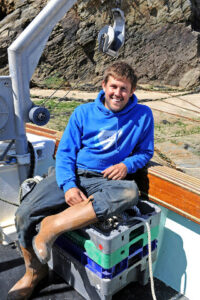
Beryl M skipper Ben Eglinton.
But his ever-increasing rank as a top Royal Navy engineer spelled the end of his Navy career. He had joined the Royal Navy for ‘hands-on engineering work, and not paperwork’, he said.
“I joined as an apprentice and did a lot of work on what became my main field – gas turbine engines. But after repeated promotions, it became more white-collar work, and I was presented with far more paperwork; I rapidly lost interest. I’d done my 15 years; I had finished my last term by project-managing multi-million-pound frigate refits, but wanted to get back into the fishing industry. I fished a lot as a youngster.
“So, with the money I had saved, I had a chance to buy a boat and refit it to what I wanted. I decided on a Holton 24; I wasn’t looking for anything else. Looking at its history, I believe that my boat began its working life in Milford Haven and was called Two Boys. It then went to Belgium and became the Gracie Mare, rigged as a shrimp trawler. It had an A-frame gantry and back aft a homemade trawl winch was fitted. Clamped to the deck and gunwales were other units like machinery for collecting, grading and processing shrimps. Every bit of space on the boat had something in it.
“I did a deal with the owner, and he knew I would look after the boat. Two weeks later, I collected it and steamed to Ramsgate single-handedly. It took some time to get there – I couldn’t get a speed above three knots. The propeller may have been suitable for shrimp fishing, but it was too large. Only 15mm space was present between the propeller tips and the hull, so above 1500rpm the cavitation was too great.
“It wasn’t the original engine, but was a pretty good Ford 4D, and it lasted well until the present re-engineering. There was nothing wrong with the Ford 4D, but they are heavy users of fuel, they do consume a fair bit of oil, and I wanted a smaller and more efficient engine.
“Passage took 13 hours, and waiting at Ramsgate were my brother Sam, and Aaron Trebilcock from Newquay. Together we took down the A-frame and masts, and the following day it was lifted onto a low-loader and driven to a farm near Newquay.”
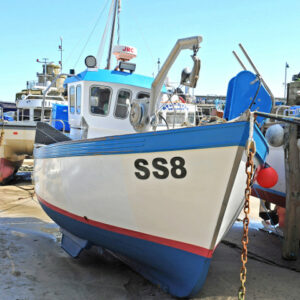
Beryl M. It’s difficult to imagine that this was once a shrimp trawler in Belgium. The bilge keels are heavy-duty iroko, further capped by stainless steel shoes – Newquay is often a harsh place for a boat not built to the standard of Beryl M.
Ben’s plan to refit the boat and re-name it the Beryl M began immediately, and the boat remained at Newquay for 10 months. “During that time, we literally took it apart; in his spare time Dad worked as the chippie, and I did the engineering and electrics. With the help of various craftsmen, and firms like Marine Engineering (Looe) Ltd – which supplied the new engine – Evolution Boats Ltd, Rock Marine Services and several more, the boat was refitted to start the first stage of its working life.”
In Belgium, it had a rudimentary flush deck (with raised coamings). The original fish hold was ahead of the engine-space, but in the first stage of refit it was moved forward and the first true flush hatch inserted into the deck. To accommodate the installation of a new engine, the remaining engine hatch and coamings were removed and replaced by the new, purpose-made flush hatch made by Evolution Boats Ltd.
It is rare to see a flush deck on a Holton 24, but by having clever scupper vents, ‘even in poor weather, the deck remains dry’, said Ben.
“On the first refit we took out the forward bulkhead and replaced it with Nidaplast; everything had to meet Seafish standards, and they were very helpful. Much more work was carried out, more than I have time to tell. I worked the boat for some time, but I wanted to have a better flush deck. The boat already had scuppers, and the deck was sound; I applied for grant aid to fit a new engine and was successful. The Volvo is a smaller and lower engine, so we could lower the engine beds and do away with the deck coaming. We capped the new engine beds with 8mm, stainless steel angle iron. Also, having a new engine allowed me to change the entire layout of the engine compartment.
“I wanted to keep the GRP aft wheelhouse, and externally it was in good condition, but internally it wasn’t. On the first stage, we took out all of the internal structures and replaced them with top-quality materials – new panels, a new console (made from iroko framing) and more. The ceiling is now made from high-grade marine plywood, and this last stage enabled us to better accommodate all the electronics and controls. Other than the GRP outer frame, in effect, it is a new wheelhouse.
“I did think of having a forward wheelhouse at one point, but on buying the boat I decided to keep its aft wheelhouse, and now there’s little chance of changing. I like the aft wheelhouse; not only for the comfort it gives, but with the flush deck and the present layout, there isn’t anything to gain from having the wheelhouse forward. I don’t think you would push as much weather as I do if it was a forward wheelhouse!”
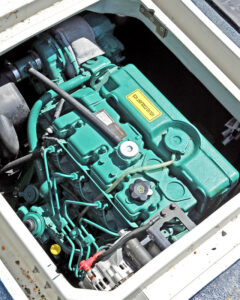
Rated as a commercial engine, the Volvo D2-75 came from Marine Engineering (Looe) Ltd.
We chatted about the new Volvo engine, a D2-75, chosen from the latest range in that series, and described by Ben as ‘a real beauty. A compact engine but a true workhorse, originally a leisure engine but now rated for commercial work’.
He added: “Fitted with a ZF gearbox at a reduction ratio of 2.68:1 it performs so well and is a quiet engine, and that is a big bonus. I managed to get grant aid for some parts of the refit, and the new engine is included. As far as the licence is concerned, I had reduced the horsepower from the previous engine (79hp) to the present Volvo rated at 75hp, and that was OK.
“Luck played a big part when I initially bought the licence. I was sitting in a waiting room browsing through findafishingboat.com and saw a licence pop up on the screen – they had just inserted the advert. It was the exact one I was after, and within 90 seconds of seeing it, I bought the licence – and the 90 seconds included consulting with Dad! These days, you need to act fast to get exactly what you’re after in the fishing industry, because the right licences, boats or gear don’t hang around for long.”
Named after Ben’s late grandmother, Beryl M is a long-term investment. Between the two refits, it clocked up a fair amount of sea time, on some days working over 15 miles from port. It gave Ben plenty of time to think, and prepare plans for the second stage of the refit. “After the refit, I worked the boat for a year before deciding to invest more and bring the boat to the present state – to be exactly what I wanted,” explained Ben.
Since completion of that refit, he describes Beryl M as ‘a very good sea boat, which has given me all that I expected, and more’.
And now, after a no-expense-spared, two-stage refit, Beryl M SS 8 is a proud member of the Cornish fishing fleet. In all respects, it is a new boat.
The Holton 24 is a traditionally-styled craft; those lines left the drawing board well over three decades ago. It has no new quirks, no special traits or any claims of being the biggest boat of its overall length of 24ft 3in and its beam of 9ft 9in. However, claims are not necessary. The Holton 24 style has a long-standing record of success, a boat that is ‘true to line’, and a hardy and robust fishing boat that surpasses many others in poor weather. Most Holton 24s are from the Mark II mould, where the sheer line was raised. Few were made from the first mould, I was told.
Including the Beryl M, I now know of four top-class Holton 24s, and it would surprise me to see any one of those skippers parting with their boats. Each skipper has paid a top-dollar for a major refit to get the boat to the standard they want, which is not something you do only to then sell it on.
New hulls are still available (from Ultra Marine in the Westcountry), and I will have far more to tell you on that quite soon.
Present layout
A lot of thought has gone into the present layout of the Beryl M.
The P-bracket arm carries a Spencer Carter 11-inch diameter slave. Taken originally from his grandfather’s GM19, Tol Bar SS 40, the P-bracket has been adapted and is well thought out; it is angled to suit Ben’s working.
The watertight hatches are robust and are well made (at Evolution Boats Ltd at Roche, and Newhaven Marine). Those of the engine compartment and fish hold provide a completely flush deck to avoid any snags or annoyances that coamings can become. Capacity of the fish hold is estimated to be about 10 boxes.
Although described as a dry deck, when loaded there is bound to be some water ingress. However, the scuppers now have stainless steel outer vents to prevent that.
Everywhere on Beryl M, there is newly-fabricated stainless steel. The rails, cat catcher and other arrangements are tailored for each specific operation. For safety, there’s even a folding ladder at the transom, and a hinged base to the cat catcher to allow access back into the boat.
Reaching the cat catcher and transom there is a remote electric pumping system to deliver flowing seawater to holding tanks – simple, but very effective.
At a considerable expense, the original galvanised-steel gunwale strakes have been replaced by brass strapping.
The Spencer Carter NHO-03 net hauler has had a taste of Navy treatment. Engineered by Ben, and aided by nearby machining firms, it was restored from being ‘in tatters’ to become as good as new.
Ben commented: “I’ve used mostly red mullet nets and/or pollack nets during the day, so I bought the bigger NHO-03 for tangle netting. This method is quite new to me, but it’s something I will be giving more time to, and having the net hauler on the port side provides a more extreme and versatile weapon.”
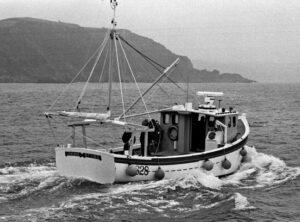
Built by John Moor of Mevagissey in 1986, Lamorna set the Eglinton family on a profitable course in the fishing industry and remained in family ownership for many years.
The shooting ramp is impressive, and is an example of how things done on the first refit have been modified. The first ramp was made of alloy, but the present, easily removable one is heavily glassed and made of Nidaplast, with rubbing boards of replaceable Tuffslip.
Two Belitronik jigging machines have been fixed onto the port side. Line fishing for pollack and mackerel is an important part of Ben’s yearly turnover. Until now he’s caught mackerel by true hand-lining, but for mackerel, the jigging machines will be in use with stainless steel strippers (now under construction) later this year.
The electronics package (mostly acquired at the first refit) now has a second VHF and antennae. Data from the video cameras in the fish hold and engine compartment are fed back to screens fitted above the console. And as well as single unit screens on the plotter, sounder and radar, a TFT screen is mounted ready for the Olex system, which is coming soon. The electronics are a Koden GTD 110 plotter; Simrad S2009 fish finder; Icom M506 VHF; Icom M323 VHF; Furuno GP39 GPS; and Koden radar.
Top-quality deck lighting and an equally top-notch searchlight are fitted.
The Volvo engine speaks for itself; there are lots of engine manufacturers for that range of power, but Volvo engines are purposely designed as marine engines.
While a normal Holton 24 has bilge keels, when in Belgium the craft had none at all. Ben has chosen large iroko bilge keels capped by stainless steel shoes. The conditions at Newquay mean that boats berthing there must be built to cope with them.
The second refit took place at Rock Marine (in Rock, opposite Padstow).
The electrics include new wiring and new isolator switches. Circuits are fed by two banks of two batteries per bank; one bank supplies the engine and the other, everything else.
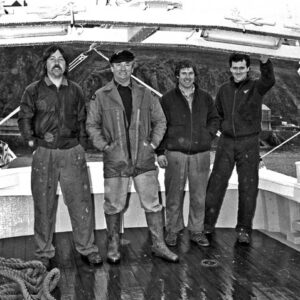
Centre is Ron Eglinton (now 89) and Gary Eglinton at his side, who now talks of retirement. I will report back if I ever see anyone with that surname retire – they don’t!
A new propulsion system came from C & O Engineering (SW) Ltd, and Ben commented: “To me, they are the best manufacturers. The new 16in-diameter propellor has a thrust of 22 inches, and is really good. I wanted a four-bladed prop, but the waiting time for that size was too long, so I settled for the three-bladed equivalent, and it pushes the boat at over seven knots (2000 rpm). I have yet to calculate the fuel consumption, but I would think it’s half that of the Ford 4D.”
Over the past four decades, I have seen fish and shellfish landed as a result of the hard work of Ben’s grandfather, shellfisherman and bass fisherman, Ron Eglinton, and his father, Gary Eglinton, and I have no doubt that Ben will follow suit and add to the list of successful Newquay fishermen.
However, I was concerned to hear that Ben’s application for a bass entitlement is now under appeal. The boat was purchased with bass fishing as one of its main earners. Like most other north Cornish skippers, Ron, Gary and Ben Eglinton have always fished for bass. It would be sad for the MMO not to consider those facts, and also that the level of fishing for any species at places like Newquay will hardly deplete the stocks. Because of the dreadful weather, if a Newquay boat of that size makes over 150 working days at sea per year, it would be a remarkable year.
And given that, whenever the weather allows it, the Newquay fishermen must fish as hard as possible, surely it is wrong to prevent long-standing bass fishermen continuing with their livelihoods.
If you are ever in Newquay, have a good look at the Holton 24, Beryl M. There are few makes of displacement fishing boats of 24ft in overall length and the Holton 24 must rank as a contender for the top of that list. A serious boat builder always says that if a fishing boat looks right, it is right. Well, to me, the Holton 24 looks 100% right.








